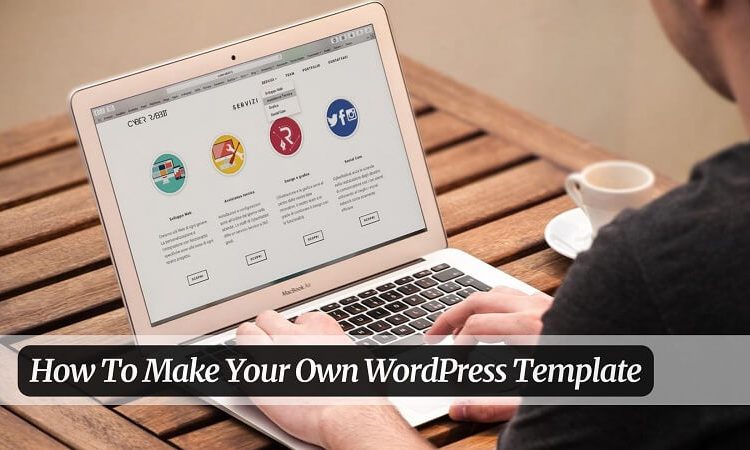How To Make Your Own WordPress Template

To make your site on WordPress, you need to add a theme. They are also called templates. This is the basis of any web resource. In this article, we will look at the stages of creating a template and layout of PSD files.
So let’s start: How To Make Your Own WordPress Template.
What Is The Purpose Of Manually Creating A Theme?
A theme is a collection of functional and style files that together define the design of a resource. The theme determines how the site will look, so it is very important to approach the process of creating a template correctly. Many are now asking the question: “Why create your own theme if you can download a ready-made one on the Internet, and for free?”. This is a logical question and there is a very comprehensive answer to it: “To make the perfect template that fully meets your requirements.”
When you buy a theme or download one from a free WordPress template directory, you are usually sacrificing quality. As a rule, such templates do not have everything suitable for you. But you resign yourself, I think that one or two nuances are not the whole picture and that later you will edit the topic. But in fact, it turns out that the site remains with an unfinished theme that you do not like. Therefore, it is better to do your own right away. And although the layout may seem complicated at first, then, when you learn, you can even create custom templates.
What Standards Does The Theme Meet?
When writing a template, it is very important to follow the official rules. Violating code, inserting a tag in the wrong place, and skipping it – can harm the design and completely spoil its appearance. You should be well acquainted with the rules for writing PHP code, as well as HTML if you are not already familiar with these languages. In addition, you will be dealing with CSS Cascading Style Sheets, so remember the basics as well – there is a lot of information on the Internet about this. Well, and the last least important requirement – create a site like a designer, and not like a schoolboy, so that you get a serious project. Otherwise, there is no point in taking this case.
All WordPress themes are hosted in the wp-content/themes/ folder. Inside this folder, there are other folders with separate themes, a file with additional functions (functions.php), style files, and images. To find data on a particular topic, you need to go to the appropriate directory. This will place the Western theme in the wp-content/themes/western/ folder.
Before you start, you should at least take a look at the structure of pre-made themes at least a few times. The default WordPress site comes with two default templates that you can review. This is the Default and Classic template. Open their files in the desired directory on the server and compare their differences.
Which Standards Does The Theme Meet?
When writing a template, it is very important to follow the official rules. Violating code, inserting a tag in the wrong place, and skipping it – can harm the design and completely spoil its appearance. You should be well acquainted with the rules for writing PHP code, as well as HTML if you are not already familiar with these languages. In addition, you will be dealing with CSS Cascading Style Sheets, so remember the basics as well – there is a lot of information on the Internet about this. Well, and the last least important requirement – create a site like a designer, and not like a schoolboy, so that you get a serious project. Otherwise, there is no point in taking this case.
All WordPress themes are hosted in the wp-content/themes/ folder. Inside this folder, there are other folders with separate themes, a file with additional functions (functions.php), style files, and images. To find data on a particular topic, you need to go to the appropriate directory. This will place the Western theme in the wp-content/themes/western/ folder.
Before you start, you should at least take a look at the structure of pre-made themes at least a few times. The default WordPress site comes with two default templates that you can review. This is the Default and Classic template. Open their files in the desired directory on the server and compare their differences.
Rules For Creating A Style.css File
First, it must conform to all CSS markup features. This file determines what your site will look like. But it will not work if you do not add a description of the created template to it. This is the first feature of WordPress that needs to be taken into account when transferring the PSD layout to the WordPress engine. You have to specify the following parameters:
- Template name.
- The URL that leads to the topic.
- A description indicating the main features of the template. Briefly.
- Author’s name. In this case, enter your name.
- Link to the author, that is, to you. You can provide a link to your social media profile.
- The name of the parent theme is optional.
- Theme version. If only created, then v. 1.0.
- Full description of the template. You can write extensively.
To make your own WordPress template, just add an edited version with a single style.css file. In this file, next to the “template” line, specify the name of the parent theme. For example, Classic if you are editing a standard template. Now the created theme will fully comply with the Classic template. Therefore, you will need to upload the files to the wp-content/themes/classic directory. Such simple themes are used, for example, on many PlayAmo online shopping or casino platforms.
In this way, you will be able to create your first, simplest theme, which can be used later. I hope you like this article on How To Make Your Own WordPress Template.
